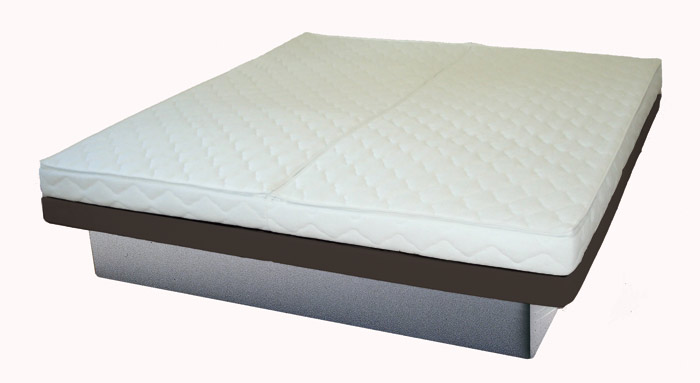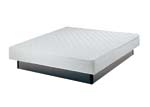Process
Description of welding a waterbed or watermattress with Radio Frequency
There are five major steps in the RF process of manufacturing a watermattress
or liner for a waterbed:
1)
Loading parts. This usually involves laying sheets of the materials
to be welded onto the lower fixture and is
not considered a critical
Operation.
2) Press actuation. This step is initiated by the operator and
is usually accomplished by the closure of two palm buttons. If
the machine is automated, the fixture
will translate the material to be welded into the press System. The press
will then lower the upper platen/electrode so that the sheets are
clamped between
the electrodes by a pre-selected clamp force.
3) RF application. Once the sheets are clamped, the RF electric field is
applied. This promotes heating and meltmg of the material clamped by the
electrodes.
The heating time is usually pre-selected by the operator.
4) Hold phase. After the RF energy is applied to the sheets, the press maintains
pressure for a pre-selected length of time (called the hold time) to allow
the melt to solidify under pressure.
5) Part unloading. If the equipment is automated, the press will open the
electrodes and the lower fixture will translate out of the press unit and
allow the operator
to remove the welded sample(s).
Table 11.1 contains a listing of the typical times required for the five
RF welding steps.
Joining
of Plastics and Composites for manufacturing a waterbed or Watermattress
Welding a special Waterbed-PVC-Foil to manufacture the watermattress.
Process Description of welding a waterbed or watermattress with Radio Frequency
Waterbed-Foils: Plastics and Composites for manufacturing waterbed foilsWaterbed Manufacturer ChinaBecause we manufacture the Waterbeds in China, we can offer you cheap prices for every article made of vinyl or foam. We are cheaper than some other waterbed factories in China or whole Asia, but we surely are not the cheapest waterbed manufacturer worldwide. Even if you buy our cheapest Waterbeds we try to do works like welding and cutting of the vinyl the best as we can and we have a long time knowledge in manufacturing waterbeds. We can manufacture waterbeds with the most durable foils produced by BAYER AG from Germany. ----------------------------------------------------------------------------------------------------------------------- |
|
| ------------------------------------------------------------------------------------------------------ |
|
| ------------------------------------------------------------------------------------------------------ |
Here you
will see the detailed description of the Waterbed / Watermattress articles
like Foam Rails, Mattress Covers, Waterbags and Liners, Waterbed Heaters. |
waterbed producer and manufacturer watermattress or waterbed mattress




